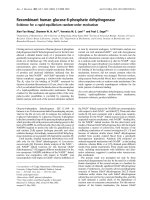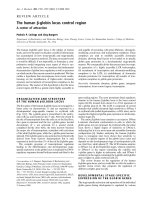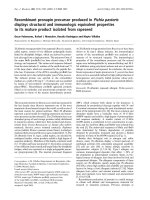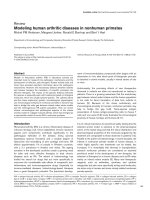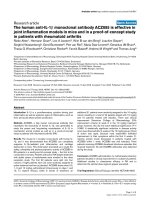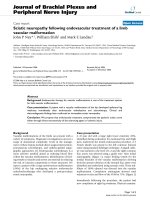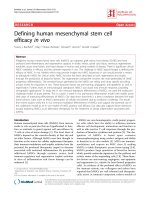Báo cáo Y học: Recombinant human glucose-6-phosphate dehydrogenase Evidence for a rapid-equilibrium random-order mechanism potx
Bạn đang xem bản rút gọn của tài liệu. Xem và tải ngay bản đầy đủ của tài liệu tại đây (396.8 KB, 8 trang )
Recombinant human glucose-6-phosphate dehydrogenase
Evidence for a rapid-equilibrium random-order mechanism
Xiao-Tao Wang
1
, Shannon W. N. Au
1,2
, Veronica M. S. Lam
1,
* and Paul C. Engel
3,
*
1
Department of Biochemistry, The University of Hong Kong, Hong Kong SAR;
2
Section of Structural Biology, Institute of Cancer
Research, Chester Beatty Laboratory, London, UK;
3
Department of Biochemistry and Conway Institute of Biomolecular and
Biomedical Research, University College Dublin, Ireland
Cloning and over-expression of human glucose 6-phosphate
dehydrogenase (Glc6P dehydrogenase) has for the first time
allowed a detailed kinetic study of a preparation that is
genetically homogeneous and in which all the protein mol-
ecules are of identical age. The steady-state kinetics of the
recombinant enzyme, studied by fluorimetric initial-rate
measurements, gave converging linear Lineweaver–Burk
plots as expected for a ternary-complex mechanism. Patterns
of product and dead-end inhibition indicated that the
enzyme can bind NADP
+
and Glc6P separately to form
binary complexes, suggesting a random-order mechanism.
The K
d
value for the binding of NADP
+
measured by
titration of protein fluorescence is 8.0 l
M
, close to the value
of 6.8 l
M
calculated from the kinetic data on the assumption
of a rapid-equilibrium random-order mechanism. Strong
evidence for this mechanism and against either of the com-
pulsory-order possibilities is provided by repeating the
kinetic analysis with each of the natural substrates replaced
in turn by structural analogues. A full kinetic analysis was
carried out with deaminoNADP
+
and with deoxyglucose
6-phosphate as the alternative substrates. In each case the
calculated dissociation constant upon switching a substrate
in a random-order mechanism (e.g. that for NADP
+
upon
changing the sugar phosphate) was indeed constant within
experimental error as expected. The calculated rate constants
for binding of the leading substrate in a compulsory-order
mechanism, however, did not remain constant when the
putative second substrate was changed. Previous workers,
using enzyme from pooled blood, have variously proposed
either compulsory-order or random-order mechanisms. Our
study appears to provide unambiguous evidence for the
latter pattern of substrate binding.
Keywords: glucose-6-phosphate dehydrogenase; steady-state
kinetics; rapid-equilibrium random-order mechanism;
alternative substrate; product inhibition.
Glucose-6-phosphate dehydrogenase (EC 1.l.1.49) in
humans is an X-chromosome-linked housekeeping enzyme,
vital for the life of every cell. It catalyses the oxidation of
D
-glucose 6-phosphate to
D
-glucono-d-lactone 6-phosphate
in the first committed stepof the pentose phosphate pathway,
which provides cells with pentoses and reducing power in the
form of NADPH. In red blood cells, this is the only source of
NADPH required to protect the cells (via glutathione [1,2]
and catalase [3,4]) against hydrogen peroxide and other
oxidative damage. Accordingly, numerous Glc6P dehydrog-
enase mutations are associated with haemolytic anaemia [5].
Until recently, detailed structural information was avail-
able only for the Glc6P dehydrogenase of Leuconostoc
mesenteroides [6]. Extensive kinetic analysis of the NAD
+
-
and NADP
+
-linked reactions for this bacterial Glc6P
dehydrogenase [7–10] suggests different mechanisms for the
two coenzymes. NADPH inhibition of the NADP
+
-linked
reaction was competitive with respect to NADP
+
and
noncompetitive with respect to Glc6P, whereas inhibition of
the NAD
+
-linked reaction by NADH was noncompetitive
with respect to both NAD
+
and Glc6P [7]. These and other
results [8–10] were consistent with a steady-state random-
mechanism for the NAD
+
-linked reaction and an ordered,
sequential reaction mechanism, with NADP
+
binding first,
for the NADP
+
-linked reaction. On the other hand, early
studies of human Glc6P dehydrogenase have left the kinetic
mechanism a matter of controversy, both because of the
conflicting conclusions of various investigators [11–13] and
because of inherent doubts about Glc6P dehydrogenase
purified from pooled, expired blood from a genetically
heterogeneous population. Adediran [14] proposed an
ordered-sequential mechanism with NADP
+
as the leading
substrate, whereas Birke et al. [15] obtained quite different
results from similar experiments. Their steady-state kinetic
study, including measurements with inhibitors and alter-
native substrates, suggested a random-order ternary-com-
plex mechanism.
The present study was prompted not only by these
unresolved disagreements but also by the need for a reliable
kinetic description of the normal enzyme as a baseline for
future studies of clinically significant Glc6P dehydrogenase
mutants. Furthermore, our recently solved crystallographic
structure of human Glc6P dehydrogenase [16,17] clearly
vindicates earlier claims that each Glc6P dehydrogenase
subunit has not one but two coenzyme binding sites, and this
in itself demands a careful check of the dependence of
reaction rates on coenzyme concentration. For this reinves-
tigation of the kinetic mechanism, the human Glc6P
Correspondence to P. Engel, Department of Biochemistry,
University College Dublin, Belfield, Dublin 4, Ireland.
Fax: + 353 1283 7211, Tel.: + 353 1716 1547,
E-mail:
Abbreviations: Glc6P, glucose 6-phosphate.
*Note: these authors contributed equally to this paper.
(Received 12 February 2002, revised 10 May 2002,
accepted 23 May 2002)
Eur. J. Biochem. 269, 3417–3424 (2002) Ó FEBS 2002 doi:10.1046/j.1432-1033.2002.03015.x
dehydrogenase gene was cloned and over-expressed in
Escherichia coli so that rate measurements could be made
with freshly prepared, kinetically homogeneous enzyme.
Studies of the reaction both with and without added dead-
end or product inhibitors were supplemented with fluores-
cence titration studies to show clearly that human Glc6P
dehydrogenase obeys a rapid-equilibrium random-order
mechanism.
MATERIALS AND METHODS
Enzymes and substrates
Restriction enzymes, calf intestinal alkaline phosphatase,
Sequenase version 2.0 DNA sequencing kit, CircumVent
TM
thermal cycle dideoxy DNA sequencing kit and other DNA
modifying enzymes for cloning and DNA markers were all
purchased from New England Biolabs. Glucose-6-phos-
phate (Glc6P), 2-deoxyglucose-6-phosphate (deoxyGlc6P),
glucosamine 6-phosphate and deaminoNADP
+
(more than
95% purity) were obtained from Sigma Chemical Com-
pany. Boehringer Mannheim (now Roche Diagnostics)
supplied NADP
+
(grade II) and NADPH (grade I). Oxid-
ized coenzymes (NADP
+
and deaminoNADP
+
)were
repurified on DE-32 columns [18]. NADP
+
concentrations
were determined spectrophotometrically at 260 nm (e
260
¼
18.0 · 10
3
M
)1
Æcm
)1
), NADPH at 340 nm (e
340
¼
6.22 · 10
3
M
)1
Æcm
)1
) and deaminoNADP
+
at 249 nm
(e
249
¼ 14.7 · 10
3
M
)1
Æcm
)1
).
Construction of the expression plasmid
All DNA manipulations were carried out by standard
procedures [19]. In order to construct a plasmid encoding the
entire human Glc6P dehydrogenase, the 5¢ end of the full-
length cDNA clone pGD-T-5B [20] was amplified with the
primers 5¢-GATGTCAGCCACTGTGGG-3¢ and 5¢-GAC
AGCGCCATGGCAGAGCA-3¢. This introduced an NcoI
site including the Glc6P dehydrogenase initiation codon to
facilitate subsequent manipulations. Digestion of the ampli-
fied fragment with NcoIandBamHI produced a 42-bp
fragment, and this was cloned into the expression vector,
pTrc99A, which has an inducible Trc promoter (Pharma-
cia). The resultant plasmid was cleaved with BamHI/SalI.
Meanwhile, the cDNA clone pGD-T-5B was digested with
BamHI/XhoI,andthe 1780-bp fragment, which corresponds
to most of the Glc6P dehydrogenase cDNA, including the 3¢
coding region, was ligated into the BamHI/SalI-cleaved
pTrc99A. The recombinant plasmid, designated pTrc/
G6PD, was shown by dideoxy sequencing to contain the
complete human Glc6P dehydrogenase coding sequence.
Expression and purification of human recombinant
Glc6
P
dehydrogenase
The expression constructs were transformed into E. coli
strain DF213 [D(eda-zwf)15, hisGl, rpsL115, metA28, mu
+
],
which is Glc6P dehydrogenase deficient (E. coli Stock
Centre, Yale University). Two hundred milliliters MM63
minimal medium [0.1
M
KH
2
PO
4
,0.015
M
(NH
4
)
2
SO
4
,
0.8 m
M
MgSO
4
,2l
M
FeSO
4
was adjusted to pH 7.0 with
KOH, and 4 mgÆmL
)1
glucose, 25 lgÆmL
)1
methionine and
histidine were added as supplements] containing
100 lgÆmL
)1
ampicillin was inoculated with 1 : 100 of an
overnight culture of E. coli containing the recombinant
Glc6P dehydrogenase plasmid, pTrc/G6PD. When the
culture reached a D
600
of 0.4–0.5, 4 m
M
isopropyl thio-b-
D
-galactoside was added to induce synthesis of human
Glc6P dehydrogenase. Harvested bacteria were resuspended
in 10 mL extraction buffer (0.1
M
Tris/HCl, 5 m
M
EDTA,
3m
M
MgCl
2
,pH7.6.with1m
M
e-amino-n-caproic acid,
0.5 m
M
PMSF, 3 lg/mL aprotinin and 0.1% 2-mercapto-
ethanol) and broken by sonication. The supernatant was
loaded onto a 2¢5¢-ADP Sepharose 4B column (1.0 · 20cm)
[21] equilibrated with 0.1
M
Tris/HCl buffer, pH 7.6
containing 5% glycerol, 1 m
M
6-amino-n-caproic acid,
3 lgÆmL
)1
aprotinin and 0.1% 2-mercaptoethanol. The
enzyme was eluted with 80 l
M
NADP
+
in this same buffer
and assessed according to the WHO guidelines [22] (data not
shown). Purity was verified by 10% SDS/PAGE [23].
Calibration of the fluorescence emitted by NADPH
and deaminoNADPH
With NADP
+
or deaminoNADP
+
as coenzyme, the activity
of Glc6P dehydrogenase was followed via the increasing
fluorescence of the reduced coenzyme. The measured fluor-
escence change has to be related to the fluorescence of a
known concentration of NADPH or deaminoNADPH.
Because deaminoNADPH of high purity is not available
commercially, the kinetic calibration method of Engel &
Hornby was used, relying on enzymatic production of known
amounts of reduced cofactor in situ [24].
Measurements of steady-state kinetic parameters
The purified enzyme was dialysed extensively against
equilibration buffer to remove the NADP
+
used in
chromatography. The reaction mixture for activity assays
contained 0.01
M
MgCl
2
,0.1
M
Tris/HCl buffer, pH 8.0,
with varying amounts of sugar phosphate and coenzyme in
a total volume of 1 mL. The buffer conditions were in
accordance with WHO guidelines [22]. An appropriate
amount of enzyme, typically in 10 lL, was added to initiate
reaction. Enzyme activity was assayed at 25 °Cwitha
recording F-4500 spectrofluorimeter (Hitachi). The excita-
tion and emission wavelengths were 340 nm and 450 nm,
respectively, with 10 nm slit widths for both lightpaths. The
working power of the lamp was 700 W. To ensure
unambiguous initial rate measurements, the enzyme addi-
tion was adjusted to give a linear fluorescence increase for at
least the first 2 min of reaction. Duplicates agreed to within
5% or better. On the day of each experiment, the specific
activity of the enzyme was checked (WHO method) to
confirm stability during storage (20% glycerol, )70 °C).
The initial-rate equation for the two-substrate reaction
catalysed by Glc6P dehydrogenase, in the nomenclature of
Dalziel [25], is of the form:
e
m
¼ U
o
þ
U
X
½X
þ
U
Y
½Y
þ
U
XY
½X½Y
ð1Þ
where X and Y are sugar phosphate and coenzyme,
respectively. The four / parameters are obtained from
initial-rate measurements at varying concentrations of X for
a series of fixed concentrations of Y. Rearrangement of the
equation shows that the intercepts of primary double
3418 X T. Wang et al. (Eur. J. Biochem. 269) Ó FEBS 2002
reciprocal plots with l/[X] as the variable, for example, are
given by /
0
+ /
Y
/[Y] and the slopes by /
X
+ /
XY
/[Y].
The secondary plots of these slopes and intercepts against
l/[Y] provide estimates for the individual initial-rate para-
meters [25]. In the present case, the lines in the primary plots
were drawn by least-squares linear fit using the
SIGMA PLOT
package. In theory, for scattered data, a simple linear fit
may introduce a false weighting. Here, however, an internal
check was applied by using both possible plotting sequences
to extract the kinetic parameters, i.e. using both 1/[X] and
1/[Y] as alternative variables for the primary plots. The close
correspondence in Table 4 and the good linearity observed
throughout argue against any serious error introduced by
the graphical procedures.
Inhibition studies
In product inhibition assays, the initial rates were measured
for a series of NADPH concentrations (0–20 l
M
)with
60 l
M
Glc6P and NADP
+
concentrations varied from 2 l
M
to 50 l
M
. A similar experiment was carried out by varying
the Glc6P concentrations from 15 l
M
to 150 l
M
and the
NADPH concentrations again from 0 l
M
to 20 l
M
while
fixing the NADP
+
concentration at 10 l
M
. In analogous
fashion, glucosamine 6-phosphate was used as an inhibitor,
covering the same combinations and ranges of substrate
concentration as used in the experiments with NADPH.
Fluorescence titration studies
Additions of NADP
+
partially quenched the fluorescence
at 345 nm emitted when purified Glc6P dehydrogenase was
excited at 290 nm. If F
E
and F
EL
are the relative fluores-
cence intensities of enzyme, E, and enzyme-ligand complex,
EL, F is the measured fluorescence at a concentration [L] of
the ligand, and K
d
is the dissociation constant of the
complex, it can be shown that:
DF ¼ F
E
À F ¼ F
EL
À F
E
À
DF
½L
 K
d
ð2Þ
The value of K
d
can thus be obtained from the negative
slope of a plot of DF/[L] against DF. Provided that total
concentration of L, free and bound, [L]
T
, is much higher
than the total enzyme concentration ([E]
T
), it can be taken
that [L] % [L]
T
.
RESULTS
Enzyme preparation
Chromatography on 2¢5¢-ADP Sepharose 4B yielded
recombinant human Glc6P dehydrogenase of 99% purity
or better as judged by SDS/PAGE (data not shown). The
specific activity was about 100 UÆmg
)1
protein. Typically
about 5 mg of purified enzyme could be obtained from 1 L
of E. coli culture. This enzyme behaved identically to
Glc6P dehydrogenase from human cells and showed
identical mobility in native gel electrophoresis (data not
shown). This agrees with the finding of Bautista et al. [26]
that recombinant human Glc6P dehydrogenase expressed
in E. coli behaves similarly to the authentic enzyme from red
cells.
Initial velocity experiments
The strictly linear and converging double reciprocal plots
obtained with different combinations of Glc6P and
NADP
+
(Fig. 1) are consistent with a sequential mechan-
ism, in which both substrates must bind to the enzyme
simultaneously before product formation can occur [25,27].
Fig. 1. Graphs to determine the various / parameters for the reaction
catalysed by human Glc6P dehydrogenase with Glc6P and NADP
+
as
substrates. (A) Primary plots of e/v vs. 1/[NADP
+
]atninefixedcon-
centrations of Glc6P. (B) Secondary plots of slopes of primary plots vs.
1/[Glc6P]. (C) Secondary plots of intercepts of primary plots vs. 1/
[Glc6P].
Scheme 1.
Ó FEBS 2002 Human glucose-6-phosphate dehydrogenase mechanism (Eur. J. Biochem. 269) 3419
The secondary plots (Fig. 1B,C), also linear, yielded the
kinetic constants and Dalziel parameters shown in
Tables 1–3. The initial-rate behaviour gives no indication
of any complexities in NADP
+
binding.
Alternative substrates
An alternative substrate, when available, can be a useful
tool for differentiating kinetic models, as first reported by
Wong & Hanes [28]. The alternative substrate and coen-
zyme used here are deoxyGlc6P and deaminoNADP
+
,and
the corresponding kinetic parameters are given in Tables 2
and 3. Sample data for deoxyGlc6P are shown in Fig. 2. A
comparison of the values of 1//
o
(¼ k
cat
) shows that the
enzyme is more active under optimal conditions with its
natural substrates. The decrease in rate is much more
marked, however, with deoxyglucose 6-phosphate than with
the coenzyme analogue, for which the factor of increase in
individual / constants is at most fourfold to fivefold
(/
Glc6P
). At lower concentrations of sugar phosphate, the
contrast between the natural substrate, Glc6P,andthe
deoxy analogue is greatly accentuated, and this is reflected
in the very high values of /
deoxyGlc6P
and /
NADP
+
deoxyGlc6P
,
which are more than 200-fold larger than the corresponding
parameters for Glc6P (Tables 1–3).
Kinetics of inhibition by NADPH and glucosamine
6-phosphate
Product inhibition patterns also offer useful evidence
regarding enzyme reaction mechanism. In this case,
6-phosphogluconolactone is labile and cannot be obtained
at high enough purity for kinetic experiments. However, it is
possible to determine the effects of NADPH on this reaction
(Figs 3 and 4). The intersection on the vertical axis in
Fig. 3A indicates competitive inhibition with respect to
NADP
+
. The linear secondary plot of the apparent K
m
vs.
inhibitor concentration (Fig. 3B) gives (y-intercept) an
apparent K
m
value of 7.08 l
M
for NADP
+
with 60 l
M
Glc6P in the absence of inhibitor, in good agreement with
the value of 6.76 l
M
calculated from the Dalziel parameters
in Tables 1–3, and a negative abscissa intercept of 9.0 l
M
for K
i
of NADPH. Similarly, for Glc6P concentrations
varied from 15 l
M
to 150 l
M
with a fixed NADP
+
concentration of 10 l
M
, NADPH concentrations from
0 l
M
to 20 l
M
gave a general noncompetitive (mixed)
inhibition pattern with respect to Glc6P (Fig. 4).
Glucosamine 6-phosphate, chosen as a dead-end inhib-
itor, was found to be competitive with respect to Glc6P
(data not shown) but general noncompetitive (mixed) with
respect to NADP
+
(Fig. 5). The apparent K
m
for Glc6P
obtained here is 50.5 l
M
, similar to 54.8 l
M
calculated from
the Dalziel parameters in Tables 1–3. The K
i
determined for
glucosamine 6-phosphate under these conditions was
1.08 m
M
.
Measurement of dissociation constant of NADP
+
Figure 6 shows that NADP
+
quenches the intrinsic fluor-
escence of Glc6P dehydrogenase. The data are consistent
with a simple binding process with a dissociation constant of
8.0 l
M
for NADP
+
. As for the kinetic measurements, the
Table 1. Dalziel parameters and their ratios for the reaction for substrates: NADP
+
and Glc6P. Kinetic data were determined by the use of primary
plots against both reciprocal of coenzyme concentration (Row 1) and sugar phosphate concentration (Row 2). The mean value obtained from each
plot is also indicated (Row 3). (Standard errors were obtained from the regression of the line of best fit through the data points).
Row
no.
/
o
(s)
/
NADP
+
(l
M
Æs)
/
Glc6P
(l
M
Æs)
/
NADP
+
Glc6P
(l
M
2
Æs)
/
NADP
+
Glc6P
/
/
NADP
+
(l
M
)
/
NADP
+
Glc6P
/
/
Glc6P
(l
M
)
/
NADP
+
Glc6P
/
/
Glc6P
/
NADP
+
(s
)1
)
k
cat
(s
)1
)
1 0.0062 ± 0.0004 0.042 ± 0.004 0.34 ± 0.007 2.3 ± 0.07 54.8 6.76 161 161
2 0.0062 ± 0.0002 0.042 ± 0.0005 0.34 ± 0.01 2.3 ± 0.03 54.8 6.76 161 161
3 0.0062 0.042 0.34 2.3 54.8 6.76 161 161
Table 2. Dalziel parameters and their ratios for the reaction for substrates: deaminoNADP
+
and Glc6P. See legend to Table 1.
Row
no.
/
o
(s)
/
deaminoNADP
+
(l
M
Æs)
/Glc6P
(l
M
Æs)
/
deamino-
NADP
+
Glc6P
(l
M
2
Æs)
/
deaminoNADP
+
Glc6P
/
/
deaminoNADP
+
(l
M
)
/
deamino-
NADP
+
Glc6P
/
/
Glc6P
(l
M
)
/
deaminoNADP
+
Glc6P
/
/
Glc6P
/
deaminoNADP
+
(s
)1
)
k
cat
(s
)1
)
1 0.014 ± 0.003 0.13 ± 0.016 1.6 ± 0.06 8.74 ± 0.29 67 5.5 42 71.4
2 0.014 ± 0.007 0.13 ± 0.005 1.6 ± 0.03 8.72 ± 0.2 67 5.5 42 71.4
3 0.014 0.13 1.6 8.73 67 5.5 42 71.4
Table 3. Dalziel parameters and their ratios for the reaction for substrates: NADP
+
and deoxyGlc6P. See legend to Table 1.
Row
no.
/
o
(s)
/
NADP
+
(l
M
Æs)
/
deoxyGlc6P
(l
M
Æs)
/
NADP
+
deoxy
Glc6P
(l
M
2
Æs)
/
NADP
+
deoxyGlc6P
/
/
NADP
+
(l
M
)
/
NADP
+
deoxyGlc6P
/
/
deoxyGlc6P
(l
M
)
/
NADP
+
deoxyGlc6P
/
/
deoxyGlc6P
/
NADP
+
(s
)1
)
k
cat
(s
)1
)
1 0.031 ± 0.003 0.27 ± 0.01 68 ± 2.5 452 ± 14 1674 6.65 25 32.3
2 0.031 ± 0.001 0.28 ± 0.005 68 ± 1.9 451 ± 8.2 1611 6.63 24 32.3
3 0.031 0.28 68 451 1643 6.64 25 32.3
3420 X T. Wang et al. (Eur. J. Biochem. 269) Ó FEBS 2002
titration appears to reflect the behaviour of only one type of
NADP
+
binding site. In contrast to the effect of coenzyme,
Glc6P produced negligible quenching.
DISCUSSION
Human Glc6P dehydrogenase has K
m
values in the
micromolar concentration range for both the sugar phos-
phate substrate and the coenzyme, and therefore their
reliable estimation requires rate measurements with very
low concentrations of each. The fluorimetric method
employed in this study allowed precise and reproducible
initial-rate measurements even for these low concentrations,
permitting a full analysis of all the initial-rate parameters
[25]. The primary plots were linear over wide ranges of
concentrations for both substrate and coenzyme. The
discovery that there are two NADP
+
binding sites on the
enzyme [17,30,31] had raised the possibility that at low
coenzyme concentrations both sites might contribute to the
observed overall pattern of binding. There was no indication
of any such complexities in these experiments. The pattern
of converging lines confirms earlier reports that human
Glc6P dehydrogenase follows a sequential mechanism
[14,15].
For a compulsory-order mechanism with substrate X
binding first to the enzyme, /
XY
//
Y
gives K
d
,the
dissociation constant for substrate X leaving the
binary-enzyme complex EX, and this value should not
change if an alternative substrate Y is used (Table 2).
Similarly, the values of /
X
and /
XY
//
X
/
Y
should remain
unchanged regardless of the nature of substrate Y, even
though there may be substantial changes to the individual
values of /
o
, /
Y
and /
XY
[25,29]. There is a correspond-
ing set of relationships if Y is the leading substrate. These
relationships were tested for Glc6P dehydrogenase by
using the alternative substrates deaminoNADP
+
and
deoxyGlc6P (Tables 1–3). Tables 1 and 3 show the results
obtained from the use of alternative sugar phosphate
substrates with the same coenzyme, NADP
+
.IfNADP
+
is the leading substrate, then /
NADP
+
Glc6P
//
Glc6P
should
be equal to /
NADP
+
deoxyGlc6P
//
deoxyGlc6P
. The mean values
obtained, 6.8 l
M
and 6.6 l
M
, respectively, were indeed
very similar. However, /
NADP
+
with Glc6P as the
substrate is 0.042 l
M
Æs, which is 6.6-fold lower than
/
NADP
+
with deoxyGlc6P asthesubstrate(0.28l
M
Æs).
Consequently, /
XY
//
X
/
Y
also reveals very different
Fig. 2. Graphs to determine the various / parameters for the reaction
catalysed by human Glc6P dehydrogenase with deoxyGlc6P and
NADP
+
as substrates. (A) Primary plots of e/v vs. 1/[NADP
+
]ateight
fixed concentrations of deoxyGlc6P. (B) Secondary plots of slopes of
primary plots vs. 1/[deoxyGlc6P]. (C) Secondary plots of intercepts of
primary plots vs. 1/[deoxyGlc6P].
Fig. 3. Product inhibition of the Glc6P dehydrogenase reaction by
NADPH: varied [NADP
+
]. (A) Lineweaver–Burk plots at a fixed
concentration of 60 l
M
Glc6P and varying concentrations of NADP
+
in the presence of a range of NADPH concentrations as indicated. (B)
Secondary replot of K
mapp
vs. the concentrations of NADPH.
Ó FEBS 2002 Human glucose-6-phosphate dehydrogenase mechanism (Eur. J. Biochem. 269) 3421
values for the two sugar phosphate substrates (161 s
)1
vs.
25 s
)1
). A compulsory-order mechanism with NADP
+
as
the leading substrate would therefore appear to be ruled
out.
Tests for a mechanism with the sugar phosphate as the
leading substrate can similarly be made by comparing the
data for alternative coenzymes (Tables 1 and 2). The mean
value of /
NADP
+
Glc6P
//
NADP
+
is 55 l
M
for NADP
+
as
coenzyme, which is reasonably close to the value of 67 l
M
obtained with deaminoNADP
+
as the coenzyme. However,
the mean value of /
Glc6P
with NADP
+
as the coenzyme
(0.34 l
M
Æs) is about five times lower than /
Glc6P
with
deaminoNADP
+
as the coenzyme (1.6 l
M
Æs). Correspond-
ingly, the value of /
NADP
+
Glc6P
//
NADP
+
/
Glc6P
(161 s
)1
)is
quite different from the value of /
deaminoNADP
+
Glc6P
/
/
deaminoNADP
+
/
Glc6P
(42 s
)1
). It thus seems that a compul-
sory-order mechanism with Glc6P as leading substrate is also
very unlikely, leaving a rapid-equilibrium random-order
sequential mechanism (Scheme 1) as the remaining option.
In the reciprocal form of the rate equation:
e
m
¼
1
k
1 þ
K
YðXÞ
K
X
K
Y
½X
þ
K
YðXÞ
½Y
þ
K
X
K
YðXÞ
½X½Y
ð3Þ
This predicts linear Lineweaver–Burk plots when the
concentration of one substrate is fixed while the other is
varied. In the more general steady-state random-order
mechanism, the reciprocal of the rate at a fixed concentra-
tion of substrate Y is a complex function [31] of the
concentration of substrate X:
½B¼
b
0
þ b
1
½Xþb
2
½X
2
a
2
½X
2
þ a
1
½X
ð4Þ
Owing to the higher-order dependence on substrate
concentration, the Lineweaver–Burk plot would not be
strictly linear. Because linear plots were observed in all the
experiments described here without any indication of a
systematic departure from this pattern, this in itself suggests
that the reaction catalysed by human Glc6P dehydrogenase
may involve a rapid-equilibrium rather than a steady-state
random-order mechanism, although admittedly the curva-
Fig. 6. Determination of dissociation constant of NADP
+
by fluores-
cence titration. DF ¼ F(E) ) F.
Fig. 5. Dead-end inhibition of the Glc6P dehydrogenase reaction by
glucosamine 6-phosphate. Lineweaver–Burk plots at a fixed concen-
tration of 60 l
M
Glc6P and varying concentrations of NADP
+
in the
presence of a range of glucosamine 6-phosphate concentrations as
indicated.
Fig. 4. Product inhibition of the Glc6P dehydrogenase reaction: varied
[Glc6P]. Lineweaver–Burk plots at a fixed concentration of 10 l
M
NADP
+
and varying concentrations of Glc6P in the presence of a
range of NADPH concentrations as indicated.
3422 X T. Wang et al. (Eur. J. Biochem. 269) Ó FEBS 2002
ture implicit in the steady-state mechanism may be difficult
to detect.
As can be deduced from Eqn (3), in a rapid-equilibrium
random-order mechanism, the values /
XY
//
Y
and /
XY
//
X
are the dissociation constants for substrates X and Y,
respectively [32]. If this is indeed the mechanism of human
Glc6P dehydrogenase, then independent estimates of the
dissociation constant for NADP
+
using Glc6P or deo-
xyGlc6P as substrates (Tables 1 and 3) should be equal
(Table 4). Similarly, the dissociation constant for Glc6P
(Tables 1 and 2) should also be the same regardless of
the coenzyme. As mentioned earlier, the value of
/
NADP
+
Glc6P
//
Glc6P
is 6.8 l
M
, which is almost the same as
/
NADP
+
deoxyGlc6P
//
deoxyGlc6P
(6.6 l
M
). This figure is also
very similar to the value of 8.0 l
M
, independently obtained
by fluorescence titration (Fig. 6). Also /
NADP
+
Glc6P
/
/
NADP
+
is 55 l
M
, similar to a value of 67 l
M
obtained for
/
deaminoNADP
+
Glc6P
//
deaminoNADP
+
.
Thus the predictions for
both substrates are adequately met for this mechanism.
Independent tests of mechanism may be applied by
using inhibitors. In the present study, NADPH was found
to be competitive with respect to NADP
+
(Fig. 3) and
general noncompetitive with respect to Glc6P (Fig. 4).
The dead-end inhibitor, glucosamine 6-phosphate is
competitive with respect to Glc6P and general noncom-
petitive with NADP
+
(Fig. 5) indicating that this
inhibitor can bind to both the free enzyme and the
enzyme–NADP
+
binary complex. Because glucosamine
6-phosphate is an analogue of Glc6P, it seems likely that
Glc6P alsocanbindtobothfreeenzymeandenzyme-
NADP
+
complex. The inhibition studies therefore suggest
that both substrate and coenzyme can bind to the free
enzyme. This in itself points towards a random-order
mechanism, further substantiating the quantitative analy-
sis above.
In summary, this study offers the first clear documenta-
tion of a rapid-equilibrium random-order mechanism for
normal human Glc6P dehydrogenase. The direct demon-
stration of crystal complexes of Glc6P dehydrogenase–
Glc6P and Glc6P dehydrogenase–NADP
+
also tends to
support this conclusion (S. W. N. Au, S. Gover & M. J.
Adams, unpublished data). The discrepancy between the
mechanisms deduced in this present study and in some
previous reports could be due to the heterogeneous origin of
the Glc6P dehydrogenase used in earlier work.
ACKNOWLEDGEMENTS
Shannon W. N. Au was supported by a University of Hong Kong
Postgraduate Studentship and the project was initiated by a seed grant
from the University of Hong Kong Committee on Research Grants.
Xiao-Tao Wang was supported, as a research assistant, by the Faculty
of Medicine Faculty Research Fund, followed by the Hong Kong
Research Grant Council HKU 7272/98M. Support from the University
of Hong Kong Committee on Research and Conference Grants is also
gratefully acknowledged.
REFERENCES
1. Gaetani, G.F., Galiano, S., Canepa, L., Ferraris, A.M. & Kirk-
man, H.N. (1989) Catalase and glutathione peroxidase are equally
active in detoxification of hydrogen peroxide in human ery-
throcytes. Blood 73, 334–339.
2. Salvemini, F., Franze, A., Iervolino, A., Filosa, A.M., Salenzano,
S. & Ursini, M.V. (1999) Enhanced glutathione levels and
oxidoresistance mediated by increased glucose-6-phosphate
dehydrogenase expression. J. Biol. Chem. 274, 2750–2757.
3. Kirkman, H.N. & Gaetani, G.F. (1984) Catalase: a tetrameric
enzyme with four tightly bound molecules of NADPH. Proc. Natl
Acad.Sci.USA81, 4343–4347.
4. Vulliamy, T., Luzzatto, L., Hirono, A. & Beutler, E. (1997)
Hematologically important mutations: glucose-6-phosphate
dehydrogenase. Blood Cells Mols. Dis 23, 302–313.
5. Kirkman, H.N., Galiano, S. & Gaetani, G.F. (1987) The function
of catalase-bound NADPH. J. Biol. Chem. 262, 660–666.
6. Rowland, P., Basak, A.K., Gover, S., Levy, H.R. & Adams, M.J.
(1994) The three dimensional structure of glucose-6-phosphate
dehydrogenase from Leuconostoc mesenteroides refined at 2A
˚
resolution. Structure 2, 1073–1087.
7. Olive, C., Geroch, M.E. & Levy, H.R. (1971) Glucose 6-phos-
phate dehydrogenase from Leuconostoc mesenteroides. Kinetic
studies. J. Biol. Chem. 246, 2047–2057.
8. Levy, H.R., Ingulli, J. & Afolayan, A. (1977) Identification of
essential arginine residues in glucose-6-phosphate dehydrogenase
from Leuconostoc mesenteroides. J. Biol. Chem. 252, 3745–3751.
9. Haghighi, B., Flynn, T.G. & Levy, H.R. (1982) Glucose 6-phos-
phate dehydrogenase from Leuconostoc mesenteroides. Isolation
and sequence of a peptide containing an essential lysine. Bio-
chemistry 21, 6415–6420.
10. Levy,H.R.,Christoff,M.,Ingulli,J.&Ho,E.M.L.(1983)Glu-
cose-6-phosphate dehydrogenase from Leuconostoc mesenteroides.
Arch. Biochem. Biophys. 222, 473–488.
11. Soldin, S.J. & Balinsky, D. (1968) The kinetic properties of human
erythrocyte glucose- 6-phosphate dehydrogenase. Biochemistry 7,
1077–1082.
12. Schroeder, L., Christoff, M. & Levy, H.R. (1984) Glucose-
6-phosphate dehydrogenase from rabbit erythrocytes. Biochim.
Biophys. Acta 784, 48–52.
13. Rosemeyer, M.A. (1987) The biochemistry of glucose-6-phosphate
dehydrogenase, 6-phosphogluconate dehydrogenase and gluta-
thione reductase. Cell Biochem. Funct. 5, 79–95.
14. Adediran, S.A. (1991) Kinetics of human glucose-6-phosphate
dehydrogenase. Biochimie 73, 1222–1218.
15. Birke, S., Kim, H.W., Periclou, A., Schorsch, B., Grouse, D. &
Craney, C. (1989) Kinetics of human erythrocyte glucose-
6-phosphate dehydrogenase dimers. Biochim. Biophys. Acta 999,
243–247.
16. Au, S.W.N., Naylor, C.E., Gover, S., Vandeputte-Rutten, L.,
Scopes, D.A., Mason, P.J., Luzzatto, L., Lam, V.M.S. & Adams,
M.J. (1999) Solution of the structure of tetrameric human glucose
6-phosphate dehydrogenase by molecular replacement. Acta
Crystallogr. D Biol. Crystallogr. 55, 826–834.
17. Au, S.W.N., Gover, S., Lam, V.M.S. & Adams, M.J. (2000)
Human glucose-6-phosphate dehydrogenase: the crystal structure
reveals a structural NADP
+
molecule and provides insights into
enzyme deficiency. Structure 8, 293–303.
18. Dickinson, F.M. & Engel, P.C. (1977) The preparation of pure
salt-free nicotinamide coenzymes. Anal. Biochem. 82, 523–531.
Table 4. Invariant / coefficients predicted for alternative A¢ and B¢.
Mechanism
Alternative substrate
A¢ B¢
Compulsory ordered None /
A
, /
AB
//
B
(A as leading substrate)
Theorell–Chance None /
o
, /
A
, /
AB
//
B
Rapid equilibrium random /
AB
//
A
/
AB
//
B
Ping Pong /
B
/
A
Ó FEBS 2002 Human glucose-6-phosphate dehydrogenase mechanism (Eur. J. Biochem. 269) 3423
19. Sambrook, J., Fritsch, E.F. & Maniatis, T. (1989) Molecular
Cloning: a Laboratory Manual, Cold Spring Harbor Laboratory
Press, Cold Spring Harbor, New York.
20. Persico, M.G., Viglietto, G., Martini, G., Toniolo, D., Paonessa,
G., Moscatelli, C., Dono, R., Vulliamy, T., Luzzatto, L. & D’Urso,
M. (1986) Isolation of human glucose 6-phosphate dehydrogenase
(G6PD) cDNA clones: primary structure of the protein and
unusual 5¢ non-coding region. Nucl Acids Res. 14, 2511–2522.
21. De Flora, A., Morelli, A., Benatti, U. & Giuliano, F. (1975) An
improved procedure for rapid isolation of glucose 6-phosphate
dehydrogenase from human erythrocytes. Arch. Biochem. Biophys.
169, 362–363.
22. WHO Scientific Group (1967) Standardization of procedures for
the study of glucose-6-phosphate dehydrogenase. WHO. Tech.
Rep. Series 366, 1–53.
23. Laemmli, U.K. (1970) Cleavage of structural proteins during the
assembly of the head of bacteriophage T4. Nature 227, 680–685.
24. Engel, P.C. & Hornby, D.P. (1987) A simple method for the ca-
libration of recording fluorimeters by kinetic means in the study of
NAD(P)
+
-dependent dehydrogenases. Biochem. Soc. Trans. 15,
386–387.
25. Dalziel, K. (1957) Initial steady state velocities in the evaluation of
enzyme-coenzyme-substrate reaction mechanisms. Acta Chem.
Scand. 11, 1706–1723.
26. Bautista, J., Mason, P. & Luzzatto, L. (1992) Purification and
properties of human glucose-6-phosphate dehydrogenase made in
E. coli. Biochim. Biophys. Acta 1119,74.
27. Fromm, H.J. (1979) Summary of kinetic reaction mechanisms.
Methods Enzymol. 63, 42–53.
28. Wong, J.T. & Hanes, C.S. (1962) Kinetic formulations for enzy-
matic reactions involving two substrates. Can. J. Biochem. Physiol.
40, 763–804.
29. Luzzatto, L. (1967) Regulation of the activity of glucose-6-phos-
phate dehydrogenase by NADP
+
and NADPH. Biochim. Bio-
phys. Acta 146, 18–25.
30. De Flora, A., Morelli, A., Benatti, U., Giuliano, F. & Molinari,
M.P. (1974) Human erythrocyte glucose 6-phosphate dehy-
drogenase.Interactionwithoxidisedandreducedcoenzyme.
Biochem. Biophys. Res. Commun. 60, 999–1005.
31. Pettersson. G. (1969) Relationships between rapid equilibrium
conditions and linearisation of the reciprocal rate equation for the
sequential random two-substrate enzyme mechanism. Acta Chem.
Scand. 23, 3243–3247.
32. Engel, P.C. (1981) Enzyme Kinetics: the Steady-State Approach,
2nd edn. Chapman & Hall, London.
3424 X T. Wang et al. (Eur. J. Biochem. 269) Ó FEBS 2002

